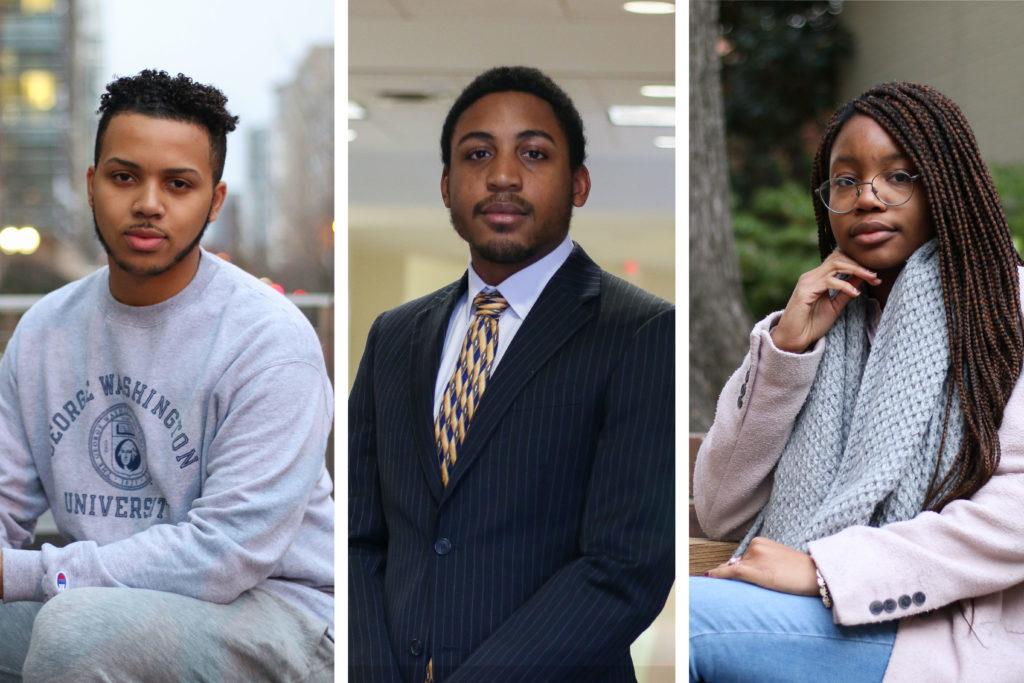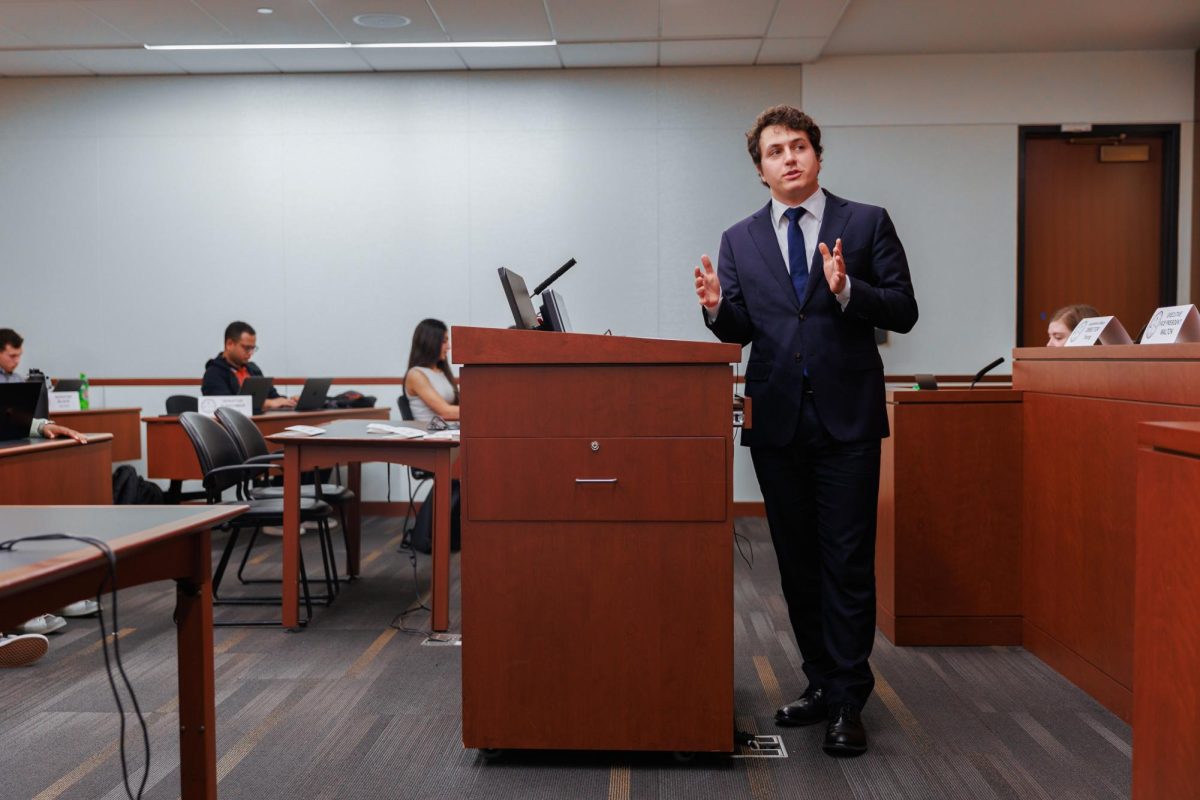Freshman Gabi Bello immediately notices one thing when she walks into her classes: the eyes.
When other students turn toward her, it is the first reminder that she is one of the few black students at a university comprised of mostly white peers. The moment makes her wonder if she made the right decision to attend GW over Harvard and Stanford universities, which also offered her admission.
Bello is one of more than 25 black students who said in interviews that while the University touts its diversity efforts, they still feel unwelcome in a predominantly white institution where just 7 percent of the undergraduate population is black. In the Class of 2021, there are 140 black students, according to institutional data.
Some freshmen said the lack of community has hampered their ability to find a place on campus and connect with other black students and faculty during their first year. Upperclassmen said while they eventually found a community on campus, the University should admit more black students and create more opportunities for black students to connect.
“GW is not diverse. I don’t know why they use that word,” Bello said. “I don’t know if they know the definition of diverse, and I don’t know if it’s because they’re a politically active school and they want to seem ‘woke,’ but literally look at yourself, look at your staff. Diverse in what? Nothing.”
Struggling to find a place
Freshman Desi Warren, a Posse Foundation scholar, said he came from a majority-black community in Atlanta and often feels uncomfortable on GW’s mostly white campus. When he first arrived on campus, he said he noticed that students often looked him up and down “as if you don’t belong here.”
He said that sentiment drives him to “make my presence felt” by pursuing leadership opportunities in organizations like the Black Student Union and the Black Men’s Initiative.
“We have to be not even twice as good, but 20 times better than the white guy who sits next to me to get half the recognition,” Warren said. “People are automatically going to assume that you’re not capable or you’re not worthy of having the same spot that they have.”
Freshman Peyton Wilson, another Posse scholar, said she would have transferred out of GW if she was not in the program because the group gives her a support network she would not have otherwise. She said the black student community exists at GW, “but it doesn’t feel like a community” because she often sees black students she doesn’t know on campus even though the population is relatively small.
“I know there are not that many of us,” she said. “So why aren’t there more opportunities for us to mingle with each other and really get to know each other?”
But she added that even within the community of black students she has met, there is often an “us versus them” mentality that black students should date or spend time with one another more so than with white students. She said some black students may also look down on those who participate in “unblack” behaviors, like wearing the brand Vineyard Vines or straightening their hair.
But she said that mentality creates “some polarization” because a person’s interests or actions do not determine their blackness.
“I feel like we have a checklist of, ‘This is what makes you black enough here,’ and if you don’t check off all the boxes, then, oh, you must be white,” she said.
Freshman Tyler Nichols, who went to high school with predominantly black and Hispanic students, said he experienced a “culture shock” when he moved to a campus where he is surrounded by white students. In October, Nichols said one of his peers said he “looked like a thug” for wearing a black beanie.
“When kids say that, in their minds, they’re like, ‘Oh it was a joke,’” Nichols said. “But they don’t understand that, because you said that, I looked at myself and I was like, ‘Wow, you’re really calling me a thug?’ To you, that may be funny. To me, that’s not.”
Freshman Kayla Mokwuah said she was “disappointed” by the relatively small number of black students on campus and found it even more difficult to connect with black peers as a biracial individual. She said her community on the women’s basketball team is “more integrated” because teammates are supportive of each other regardless of race.
“I grew up in a white town,” Mokwuah said. “I’m not black enough and I’m not white enough, so I’m just floating in the middle.”
Creating community
Sophomore Kahleel Hester, the president of GW Posse, said that while the proportion of black students is relatively small, the community does come together, especially in times of conflict, like when a racist Snapchat sparked outrage on campus last semester.
“Sometimes, we can be a little fragmented because that is college and we all have our own goals and agendas,” he said. “But at the end of the day, the GW black community is a community and we do come together when we need to address something.”
Students hosted public forums following the Snapchat post, prompting action from both the Student Association and administrators. The Black Student Union also held a town hall last month where students raised a series of issues facing the black community.
Hester added that black student organizations are open to everyone, including students who are not black. He said he wishes non-black students attended events like study halls and general body meetings hosted by black student groups so students could better understand their community.
Senior Imani Ross – a former SA senator who spearheaded a diversity and inclusion assembly during her tenure and drafted legislation condemning the Snapchat post – said officials also need to admit more black students. She said black students lack institutional support that would help them better foster a community.
“Why, as a student, should I be responsible for creating and curating a community?” Ross said.
‘The perfect balance’
Caroline Laguerre-Brown, the vice provost for diversity, equity and community engagement, said officials are “acutely aware” that the black student community is not a “monolith.” Black students come to GW from across the United States and countries in the Caribbean, Africa and Latin America.
She said officials support efforts to create a community in student groups “that meet the diverse social and cultural needs of black students,” as seen in the 20 black student organizations on campus.
“All of this rich diversity of experience makes the creation of community that meets every student’s needs extremely challenging,” she said in an email. “We fully embrace that challenge, of course, but recognize that we will always be chasing after the perfect balance.”
Michael Tapscott, the director of the Multicultural Student Services Center, said students can find support in organizations on campus, but faculty and staff can “do a better job” of promoting multicultural events and programming.
“We have amazing resources for the black community here, and when we hear there is a need, we work with the community to try to fill it,” he said in an email. “Community building is a two-way street. We need to hear and to know when a student is struggling here. It is the only way we can help.”
Michael Wenger, a sociology professor teaching a class about race and minority relations, said the University should hire more professors of color because “having diverse perspectives enriches classes no matter what kind of classes they are.” He said black students can also look up to professors who represent their community.
The percentage of underrepresented minority faculty in 2017 stood at 5.7 percent, according to institutional data. The data does not break down the numbers by racial or ethnic group.
“I think administrators and faculty have a serious responsibility to not only preside over a diverse campus but to preside over and take steps to make sure it is not only a diverse campus but an integrated campus,” he said.





